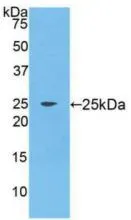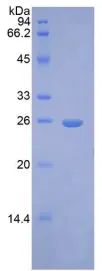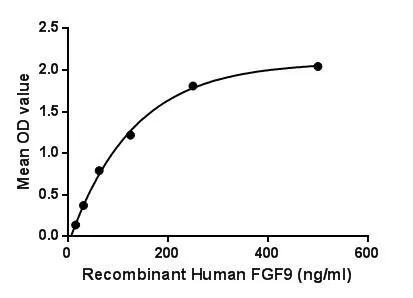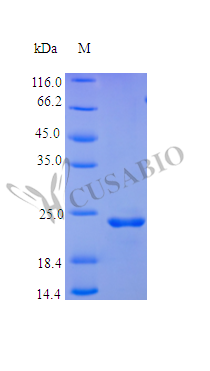
WB analysis of GTX00225-pro Human FGF9 protein.
Human FGF9 protein, His tag
GTX00225-PRO
ApplicationsFunctional Assay
Product group Proteins / Signaling Molecules
Protein IDP31371
Overview
- SupplierGeneTex
- Product NameHuman FGF9 protein, His tag
- Delivery Days Customer9
- Application Supplier NoteFibroblast Growth Factor 9 (FGF9) is a member of the fibroblast growth factor (FGF) family. FGF family members possess broad mitogenic and cell survival activities, and are involved in a variety of biological processes, including embryonic development, cell growth, morphogenesis, tissue repair, tumor growth and invasion. FGF9 was isolated as a secreted factor that exhibits a growth-stimulating effect on cultured glial cells. In nervous system, this protein is produced mainly by neurons and may be important for glial cell development. Besides, Fibroblast Growth Factor Receptor 1 (FGFR1) has been identified as an interactor of FGF6, thus a binding ELISA assay was conducted to detect the interaction of recombinant human FGF9 and recombinant human FGFR1. Briefly, FGF9 were diluted serially in PBS with 0.01% BSA (pH 7.4). Duplicate samples of 100 microl were then transferred to FGFR1-coated microtiter wells and incubated for 2h at 37C. Wells were washed with PBST and incubated for 1h with anti-FGF9 pAb, then aspirated and washed 3 times. After incubation with HRP labelled secondary antibody, wells were aspirated and washed 3 times. With the addition of substrate solution, wells were incubated 15-25 minutes at 37C. Finally, add 50 microl stop solution to the wells and read at 450nm immediately. The binding activity of FGF9 and FGFR1 was in a dose dependent manner.
- ApplicationsFunctional Assay
- CertificationResearch Use Only
- ConjugateUnconjugated
- Protein IDP31371
- Protein NameFibroblast growth factor 9
- Scientific DescriptionThe protein encoded by this gene is a member of the fibroblast growth factor (FGF) family. FGF family members possess broad mitogenic and cell survival activities, and are involved in a variety of biological processes, including embryonic development, cell growth, morphogenesis, tissue repair, tumor growth and invasion. This protein was isolated as a secreted factor that exhibits a growth-stimulating effect on cultured glial cells. In nervous system, this protein is produced mainly by neurons and may be important for glial cell development. Expression of the mouse homolog of this gene was found to be dependent on Sonic hedgehog (Shh) signaling. Mice lacking the homolog gene displayed a male-to-female sex reversal phenotype, which suggested a role in testicular embryogenesis. [provided by RefSeq, Jul 2008]
- Storage Instruction-20°C or -80°C,2°C to 8°C
- UNSPSC12352202





